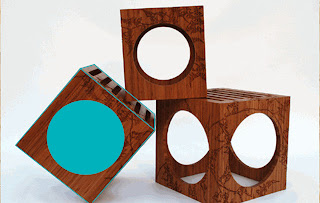Primary Solids
A primary solid is an extension or rotation of shape that creates something with volume. These forms are all regular and can be distinguished easily. They are made from regular shapes such as squares, circles, and triangles. For example, a circle can make either a sphere or a cylinder. A square can make a cube. And a triangle can make a cone or pyramid. I chose this image in particular because it exhibited an example of three of the primary solids. These three forms include a cylinder, a cube, and a sphere.
Dimensional Transformation
Dimensional transformation is a specific branch of transformation of form. There are several ways in which form can be transformed. When referring to dimensional transformation, we are only referring to the alteration of one or more of a forms dimensions. Therefore, the qualities of the form are the same it is simply the size, as in height, width, or length, that is changed. I chose to use this image to explain this vocabulary because it has taken the cube, a primary solid, and altered certain dimension. The length was enlarge and the height was greatly diminished. making the cube into steps for a unique staircase.
Subtractive Forms
Another way in which form can be manipulated to create an interesting object is through using subtractive forms. Basically, when we see something, we automatically want to make it something whole even if it has certain parts missing. So, if you were to see a box with a corner cut off of it, you would still be able to see the box that was originally there. This is the concept used for subtractive form. The image I chose for this example to depict subtractive form serves its purpose because anyone viewing it can see a complete box even though there are several openings and cuts through out the object.
Additive Forms: Radial Forms
Additive forms can include several different possibilities. Spatial tension, edge to edge contact, face to face contact, interlocking volumes, centralized form, linear form, radial form, clustered form, and grid form are all examples of additive forms. The one that I chose to focus on in my analysis is radial form. This is when a grouping of linear forms are brought together by and radiate from a centralized form. The image used for this transformation of form is a building with three wings that radiate from a central point. Perfectly depicting what a radial form would be.
Formal Collision of Geometry:Circle and Square
The final way to alter form that will be discussed in this chapter is the formal collision of geometry. This occurs when either two or more different geometric forms are united to create one form in which both forms will fight for visual importance. This also occurs if one geometric form but in two or more differing orientations are combined. I feel that the image I picked for this term is appropriate because it shows a circle and square coming together to create an interesting form where both the circle and square fight for importance.
About Me

- Paula Cuevas
- My name is Paula Cuevas. I am an Interior Design major at SCAD. SCAD is currently the #1 school for Interior Design in the country. Which probably explains why the work is 1000x harder than what you would expect and the idea of sleep is a luxury. My desire to one day become an innovative and influential designer is what keeps me going. I plan on traveling the world in order to soak up all the different cultures and styles it has to offer. Hopefully, this will enhance my design style even further. My philosophy towards design is that with an OPEN MIND, possibilities become endless.















